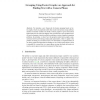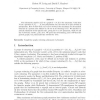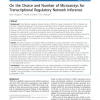924 search results - page 3 / 185 » On the number of ordered factorizations of natural numbers |
SODA
2004
ACM
13 years 7 months ago
2004
ACM
The analyses of many algorithms and data structures (such as digital search trees) for searching and sorting are based on the representation of the keys involved as bit strings and...
GBRPR
2007
Springer
14 years 6 days ago
2007
Springer
Abstract. We introduce a new framework for feature grouping based on factor graphs, which are graphical models that encode interactions among arbitrary numbers of random variables....
DAM
1999
13 years 5 months ago
1999
The achromatic number (G) of a graph G = (V, E) is the maximum k such that V has a partition V1, V2, . . . , Vk into independent sets, the union of no pair of which is independent...
BMCBI
2010
13 years 6 months ago
2010
Background: Transcriptional regulatory network inference (TRNI) from large compendia of DNA microarrays has become a fundamental approach for discovering transcription factor (TF)...
EUROCRYPT
1999
Springer
13 years 10 months ago
1999
Springer
Abstract. We present the first efficient statistical zero-knowledge protocols to prove statements such as: – A committed number is a prime. – A committed (or revealed) number ...



